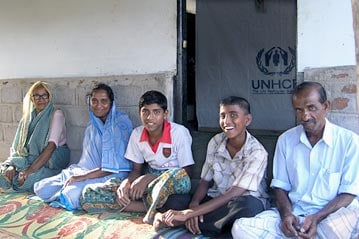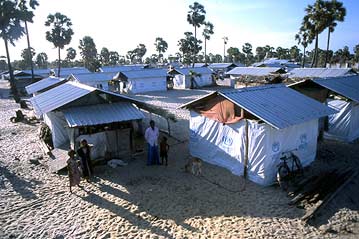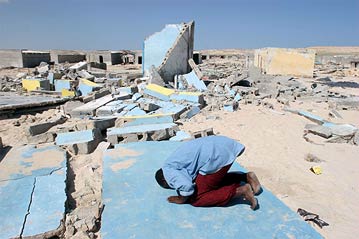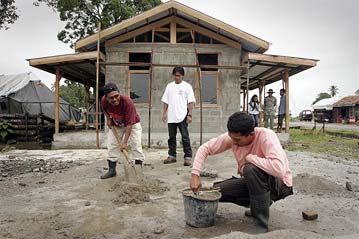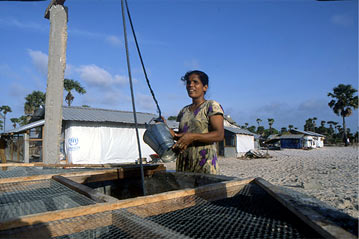Sri Lankan tsunami victims get new temporary homes
Sri Lankan tsunami victims get new temporary homes

AMPARA, April 8, (UNHCR) - Tsunami-displaced families in Ampara district in eastern Sri Lanka started getting new homes on Thursday as the UN refugee agency handed over 42 temporary houses in Kalmunai as part of a pilot housing project. The task has been made more urgent with the onset of the monsoon rains which are forcing some displaced people out of their tents and into temples, churches and schools.
At the handover ceremony, UNHCR's top official in Sri Lanka, James Lynch, said he was pleased to see the delight of the new homeowners who had previously been living in tents or with relatives.
A further 2,500 houses are scheduled to be built for Ampara district, with the pilot scheme allowing vital feedback from the new householders for the final design of the two-roomed aluminium zinc-roofed homes built on brick foundations.
"The process of building transitional shelters is as important as the outcome. Close consultation with beneficiaries is vital to UNHCR when planning the construction of shelters," Lynch said. "We aim to keep communities together, and this requires careful attention in the process of identifying land on which to build," he added.
The devastating tsunami of 26 December 2004 claimed 900 lives in Marathamunai, Kalmunai, and at the height of the crisis displaced over 900,000 people in the country. The tsunami reduced the family home of Zafira - only 30 metres from the shore - to rubble and, she lost her seven-year-old son.
"The tsunami took away my son, my home and all my possessions," Zafira said. "My husband does not now want to return to his fishing, instead he hopes to work as a local vendor and earn a living around Marathamunai," she added. Moving into her new home after living in a tent for the last few months, brought a smile to her face once more.
The new temporary homes have been built by UNHCR's partner the Rural Development Foundation (RDF), with water and sanitation provided by UNICEF. When the final design is ready, the planned temporary homes will be built at the rate of 500 a month. UNHCR has pledged to build a further 1,500 houses if needed.
"The tragically high loss of life, the number of those displaced, and the sheer size of the District, have presented significant challenges to all the UN agencies and NGOs working in Ampara. But now we can see real progress being made - people displaced by the tsunami moving into durable and safe accommodation, able to look to a more hopeful future," said the UN Humanitarian Coordinator in Sri Lanka, Miguel Bermeo at the ceremony.
The temporary homes, (measuring 12 x 16 feet) consist of two partitioned rooms built within a galvanized iron frame, and are compliant with the internationally recognized SPHERE standards for a family of five persons. The brick foundation provides a firm, impregnable base, with plywood upper walls.
The roofs are made of zinc aluminium which does not conduct heat to the same degree as cheaper roofing options, creating a more comfortable living environment. All new homes will have a lockable window and door.
Lynch said the temporary homes can be tailored to suit the needs of the homeowners.
"For example, they can be painted or have ceilings installed. Assembled from a standard package of equipment, the shelters are specifically designed to ensure there is no wastage of materials. And, the shelters can be disassembled and reassembled in another location if necessary," Lynch added.
UNHCR is also working on transitional shelter projects in Ampara and in Jaffna, where it recently completed 210 temporary homes outside Manikadu town. A future transitional shelter project is planned for Trincomalee. Overall, UNHCR plans 6,200 [corrected from 6,500 April 12] temporary homes for tsunami victims in Sri Lanka.
The UN refugee agency has been in Sri Lanka since 1987, assisting people uprooted by the civil conflict and more recently, those displaced by the tsunami.

